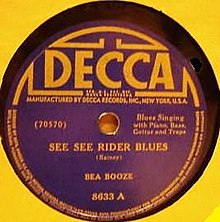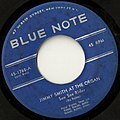CC rider
CC Rider (title variants: See See Rider Blues , CC Rider Blues or See See Rider , rarely Easy Rider or Cee Cee Rider ) is one of Ma Rainey written with Lena Arrant Blues . Rainey recorded the title, which has now become one of the blues and jazz standards and has become one of the most frequently recorded blues songs, in 1924.
Form and content of the song
CC Rider is considered to be "the prototype of the 12-bar blues , which works its way from the tonic over the subdominant to the dominant in three equal parts and repeats this (in an AABA scheme)." The text is about a woman who has been betrayed who does not accept the loss, but thinks about resistance. It says: “Look what you did to me: I loved you, and now your girl has come back. I'll buy a gun that's as long as me, shoot my friend and throw myself in front of a cannon. "
History of origin
The 37-year-old blues singer Ma Rainey received a recording contract with the small Paramount Records label in December 1923. The eight tracks that were written that same month contained the word blues as a component, the first single was Bo Weevil Blues / Last Minute Blues (# 12080). She had released a total of eleven singles until the See See Rider Blues / Jealous Hearted Blues was released as the twelfth single in January 1925.
There are a variety of interpretations of how titles and text are to be interpreted. The abbreviation "CC Rider" is supposed to stand for the Canadian whiskey brand "Canadian Club", which was popular in the southern states in the 20s. Another version assumes that it refers to a wandering guitarist who was traveling in the Chitlin 'Circuit (CC) of the Mississippi Delta . Other writers want to recognize a hobo (a passenger illegally ridden on freight trains) who rides on Colorado Central trains.
Ma Rainey's original text does not provide anything for these theses, rather it is about a love triangle, which the singer wants to put an end to by using pistols against her rival. "See see" is the pronounced or sung form of the abbreviation CC Rider , but can also be understood in the sense of "see". It is also used in the text line “see what you have done”. Ambiguities make a safe interpretation difficult. Paul Ackerman interprets it as the typical form of partnership infidelity. It is also possible that CC Rider stands for the Easy Rider , the sexual partner. According to Big Bill Broonzy , the song was written in 1908 and, in its original version , is about a man who is on the Mississippi in a barge.
With ASCAP the composition is registered as See See Rider for Gertrude Rainey and Lena Arrant (Arrant also wrote the Jelly Bean Blues ). Sandra Robin Lieb suspects in her biography about Ma Rainey that Arrant is not the composer of the song, but contributed several rhyming couplet lines to CC Rider .
Recording and publication
The song was written again on October 16, 1924 in New York for the Paramount label (# 12252). Rainey is accompanied under the name "Ma Rainey & Her Georgia Jazz Band" by the young Louis Armstrong (cornett), clarinetist Buster Bailey , Fletcher Henderson (piano), Charlie Dixon (banjo) and Charlie Green (trombone). Armstrong, Bailey and Dixon were members of Fletcher Henderson's band at the time. After publication in January 1925, the title reached number 14 on the American charts and was Rainey's only chart placement of all singles. Rainey then recorded another 35 singles for Paramount until September 1928, when she ended her recording career.
Cover versions
The number and importance of the cover versions have contributed to the classic status of the song. The title was covered across styles in blues , jazz and pop . Apparently the first cover is from Ma Rainey's label colleague Blind Lemon Jefferson (under the title Easy Rider Blues ), recorded on March 15, 1927. Alfred Lewis follows with the Easy Rider's Blues (May 5, 1930), Big Bill Broonzy records it twice ( as Big Bill ; October 19, 1934 and February 17, 1956), Georgia White is in the recording studio with the Bluestit on July 15, 1935. Leadbelly recorded the track several times, for the first time on February 13, 1935 with his 12-string bottleneck- style guitar (then on June 17, 1940 and three more times, last recording on October 15, 1948). "Wee" Bea Booze (March 26, 1942) was the first and only one who carried the song to # 1 in the new R&B charts for 4 weeks after it was released in November 1942. One of the first recordings for Ray Charles was See See Rider (with the Ray Charles Trio) in May 1950 on the Swing Time label (# 217).
Ella Fitzgerald and Duke Ellington have recorded in jazz, as have organists Jimmy Smith (1959) and Jimmy McGriff , but also Donald Byrd and JJ Johnson and even Archie Shepp and Yusef Lateef C. C. Rider .
Sonny Til and the Orioles recorded a Doo Wop version on July 8, 1952 as the b-side of Don't Cry Baby ; Chuck Willis released an interesting Rhythm & Blues version (January 31, 1957) that was ranked 12th in the pop charts. LaVern Baker reached number 34 in the pop charts and number 9 on the R&B charts with the version created on September 26, 1962, Peggy Lee recorded him for the LP Sugar-n-Spice (October 1962). BB King (June 22, 1965) did not enter the charts with his version.
Eric Burdon and the Animals , who are strongly oriented towards rhythm and blues , had a recording session under producer Tom Wilson in New York in July 1966 together with Frank Zappa , from which a shortened version of See See Rider / She'll Return it (MGM # K13582 ) was pressed to single and advanced to rank 10 in the USA. In Canada, the Animals even reached the top position on the charts. After that single, they renamed themselves Eric Burdon & The Animals. Mitch Ryder & The Detroit Wheels paired CC Rider with Jenny Take a Ride as a medley in January 1966, Joe Tex already recorded the title on September 10, 1965, but it did not make it onto the B-side of A Woman's Hands until July 1967 Market. Elvis Presley recorded the song live on February 17th, 1970 at the International Hotel in Las Vegas and used it as the opener of his live shows there.
Coverinfo lists 33 versions, but there are probably over 100 versions worldwide.
Individual evidence
- ^ A b c Hans-Jürgen Schaal (Ed.): Jazz standards. The encyclopedia. 3rd, revised edition. Bärenreiter, Kassel u. a. 2004, ISBN 3-7618-1414-3 , pp. 421f.
- ↑ Blue Centric ( Memento of 8 February 2012 at the Internet Archive )
- ↑ Billboard Magazine, June 29, 1959, Jazz Form Developed from Many, Varied Influences , p. 26
- ↑ Russell L Goings The Children of Children Keep Coming: An Epic Griotsong 2009, p. 271 and Sandra R. Lieb Mother of the Blues: Study of Ma Rainey 1983, p. 99
- ↑ cf. the Folkways LP Big Bill Broonzy Interviewed by Studs Terkel , Folkways FG 3586 (recorded in Chicago on November 14, 1956), and Roger House Blue Smoke: The Recorded Journey of Big Bill Broonzy 2010, p. 19ff.
- ↑ Sandra R. Lieb Mother of the Blues: Study of Ma Rainey 1983, p. 64
- ↑ Woody Mann, Bottleneck Blues Guitar , 1996, p. 92
- ↑ Cover info, entry See See Rider





